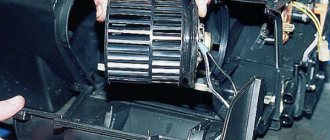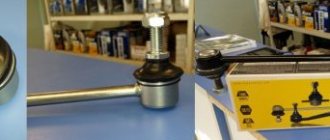The heating, ventilation and air conditioning system of the Vesta's interior differs from similar systems of other Lada models. The difference is not only in its design, but also in the control method. Let's look at the design features of the Vesta stove, and also evaluate its effectiveness.
Stove (heater) Lada Vesta, device and reviews
The heating, ventilation and air conditioning system of the Vesta's interior differs from similar systems of other Lada models. The difference is not only in its design, but also in the control method. Let's look at the design features of the Vesta stove, and also evaluate its effectiveness.
Barely warm or cold air
During operation in various climatic conditions, all vehicle systems are subject to various types of contamination. Dust accumulates in the stove radiator and impairs its heat transfer. Therefore, over time, the temperature of the output air decreases. As a rule, such a malfunction is eliminated by replacing the heater radiator or by flushing it with a special liquid.
A low level of antifreeze can also cause a malfunction. If the coolant in the tank is less than “MIN”, then air will enter the system, which will create a “plug” in it. To make sure of this, you need to check the pipes in the engine compartment. With the engine fully warmed up, all radiator pipes should be hot. If you find it cold, there is most likely air in the system. To “de-air” you can use a simple method. Using a high jack, lift the part of the car in which the expansion tank is located and let the engine run for 1-2 minutes at high speeds (2-3 thousand). The air lock should come out.
Elements of the ventilation and heating system
The stove body (in Fig. No. 5) is located in the car interior under the instrument panel frame. Inside the case there are:
- heater radiator;
- electric fan;
- fan speed controller (RFV) or additional resistor;
- air flow distribution damper;
- gear motor that regulates the dampers;
- air filter.
The heater radiator releases heat to heat the interior. Located inside the case on the left side. To replace it, you will have to remove the upper frame (lining) of the panel (dashboard).
An electric fan forces air into the car interior through air ducts. It is located on the other (right) side of the body. Access to it opens after removing the glove compartment.
The additional resistor is designed to regulate the rotation speed of the fan motor. It is installed on the heater housing on the driver's side.
The cabin filter cleans the air entering the cabin. Located in the heater block on the passenger side. It is replaced from inside the car (and not from the engine compartment, as on Grant, Kalina or Priora). In addition, the filter element resource is 30,000 km, and not the usual 15 thousand km.
The job of the gear motor is to regulate the position of the damper, which distributes air throughout the cabin. How this happens is shown in the video:
Air temperature sensors in the cabin and outside transmit readings to the engine control unit (ECU).
The control unit for the stove (heater) and air conditioner (SAUKU) is designed to regulate the air temperature in the cabin, change the speed and direction of air flows, and control the heaters. Depending on the configuration, the SAUKU may differ slightly. There are three types in total:
- SAUKU without air conditioning;
- SAUKU with air conditioning;
- SAUKU with climate control.
Lada Vesta MMC shortcuts can be dragged and dropped
The heater should be checked before the start of the winter season, and also several times in winter. Then troubles will not take you by surprise. To do this, you need to check the operation in all modes and evaluate:
- Does the air heat up and how quickly?
- Does the flow of air masses change with a change in command;
- Are there any extraneous noises?
- In general, are you satisfied with the operation of the heater?
Particular attention should be paid to the same temperature of the pipes. If the difference in the heating of rubber pipelines is significant, this means a serious problem
It's worth finding. In the worst case, this means replacing the Vesta radiator; in the best case, airing or a low level of antifreeze.
Hello again. I often, very often come across posts here on VK about how the stove in Vesta doesn’t heat well. Such complaints appeared almost immediately after the sedan entered the market. And recently, various modifications to the heater and dampers have appeared (for example, a spring on the damper).
10.30. The thermometer does not show below zero. No divisions. It is quite accurate, but indoors. It's about -10 in the car.
10.38. Traveled 1.5 km. The engine temperature is already about 70, warm air is blowing from the deflectors. It's still cool in the cabin.
10.45. I drove exactly 6 km. I arrived in the yard. From the moment of launch 15 minutes. The thermometer shows 10 in the cabin. It turns out that the heater has heated up by 20 degrees.
Mileage: 24000 km
You should start with the fact that the stove body is located under the dashboard frame. What parts does the system consist of?
- Air filter.
- Stove radiator.
- Fan.
- Damper regulating gearbox.
- Additional resistor.
- Air flow distributor.
The radiator of the LADA Vesta heater produces and releases heat into the cabin. The fan is designed to supply air to the vehicle interior. Using a part such as a resistor, the speed is adjusted.
You can work with the stove using the SAUKU or “heater and air conditioning control unit”. The AvtoVAZ company installs three control units on its cars on various trim levels.
The LADA Vesta heater fan directs air to the feet of the passenger and driver, to the windows and directly into the passenger compartment. With the help of deflectors, the driver can regulate the direction of air flows and their strength.
A function has been added to LADA Vesta with which the driver or passengers can easily cool a bottle of mineral water or Coke. The refrigerated glove compartment will comfortably hold your favorite soft drinks and keep them cool even on the hottest day.
The main screen of the Lada Vesta multimedia system (MMS) contains shortcuts, the location of which can be changed to your liking. Hold the shortcut for a few seconds, then drag it to the desired location. It is noteworthy that nothing is said about this in the car's operating manual.
To turn on the heated windshield without maximum windshield blowing, turn on the “Defrost MAX” mode (button No. 24), and then simultaneously press buttons No. 24 and No. 21. As a result, the windshield heating will work, and the climate system fan will remain running at the same speed.
Few people know that Vesta’s standard multimedia system has a secret service menu. It contains the following functions:
- Software - software version, firmware, etc.
- System status - system status.
- Data save - saving data.
- Key test - key test.
- Fan test - fan test.
- Decoction test
- Initialize - initialization.
- RVC test
- Diagnostic - diagnostics.
- Screen Adjust - screen adjustment, calibration.
- GPS test - GPS test (satellites).
- Activation Mac - Mac activation.
- Screen test - test the screen (you can make it dark so it doesn’t glare).
- Backlight test - backlight test.
- Can test - Can test.
The trunk of the Lada Vesta station wagon pleases with its good organization of space. When designing its interior space, the company took into account the opinion of car enthusiasts. For comfortable placement, it has various niches, hooks and pockets. However, this is not the limit of possibilities. One of the Lada Vesta SW owners found another hidden place in the trunk of their car where they can store rags and other soft items. More details.
Interior ventilation diagram
Air ducts run from the stove body, which direct air flows to the windows, into the interior and legs. The central deflectors can adjust air flow in different directions, and its strength is controlled using a horizontal wheel underneath them.
AvtoVAZ has implemented airflow for the Vesta driver’s feet in a new way. The air duct nozzle is located not on the side, but above the foot of the right foot. Some owners of the new sedan believe that this design is not very successful, because It warms the toes worse than the foot itself. For the front passenger, the air duct exits closer to the wall of the engine shield and a similar situation will not arise.
Worth o. On versions of the car with air conditioning, a small air duct fits into the glove compartment, which can cool, for example, a water bottle.
Why do windows fog up?
The car windows should not fog up while the heater is operating. If this happens, then the cause may be:
- heater core leaking
- cabin filter is clogged
- The electric recirculation air damper actuator is faulty
Let us remind you that fan vibrations may also occur during heater operation.
Heater and air conditioner control
“Classic” block without air conditioning
Left regulator (No. 9) – supply air temperature control; Right (No. 17) - air flow regulation; Buttons (No. 11-16) - setting the direction of air flow.
Comfort unit with air conditioning
The left regulator additionally has the function of turning on the air conditioner (No. 18), and the right one has the function of turning on air recirculation (No. 19). Otherwise, the control of supply air temperature, fan speed and air flow distribution of the Comfort version of the system is similar to the Classic version.
Luxe unit with climate control
Two buttons are replaced on the control unit:
- “Defrost MAX” mode (No. 24) - the air conditioning is forcibly turned on (if conditions permit), electric heating of the windshield and rear windows and side rear-view mirrors. The entire air flow is directed to the blower nozzles of the windshield and front side windows, and the maximum speed and air temperature are set.
- “AUTO” mode - in this mode, the air flow intensity (fan speed) and one or another air flow distribution mode are automatically set depending on the outside air temperature, the cabin air temperature and the coolant temperature of the engine cooling system.
The information display (No. 10) has also undergone changes; the air temperature scale has been replaced with numbers.
How to disable DRL without interfering with the wiring
On LADA cars, daytime running lights light up automatically after the engine is started. In some situations, there is no need for DRLs to operate (for example, during auto start at night).
To disable the DRL on LADA cars (Granta, Kalina and Priora), in which the light is controlled using the MUS (lighting control module), you should set the block knob to the middle position between the “circle” and “dimensions”.
To turn off the DRL on LADA cars (XRAY, Vesta and Largus), in which the light is controlled using the left steering column switch, you should similarly set the position of the regulator to an intermediate position.
On Lada Granta, Lada Kalina, Lada Priora and Lada 4×4 cars it is possible to turn off the sound signal of an unfastened seat belt programmatically. To do this, you need to press and hold the daily mileage reset button on the instrument panel, and within 10 seconds fasten and unfasten the belt 2 times. To turn it on: the same procedure, only you need to fasten and unbuckle the belt 3 times.
Attention! Always wear your seat belts!
Reviews about the Vesta stove
The first reviews from Vesta owners about the stove are generally positive. No significant deficiencies were identified. The car warms up quickly. It blows quite strongly from all the air duct nozzles. In cold weather at -25 degrees, the car interior is warm and comfortable. When using the control unit and adjusting the deflectors, the cost of the parts is not visible; in terms of quality, it resembles a foreign car.
To improve the efficiency of the heater, close the glove compartment cooling in winter:
Let us remind you that with the first cold snap we were also able to test the operation of the heating. You can find other information about Vesta that interests you in this content. By the way, problems with the operation of the stove can be caused by an air lock in the cooling system.
How does your Vesta’s stove heat? In the comments to the article we leave impressions and notes about the efficiency of the heater.
Categories of products that you may be interested in based on the article “Stove (heater) Lada Vesta, device and reviews”:
Problems
Stove motor During operation, the device may become unusable or reduce its efficiency.
We check the fan at all four speeds:
- if the fan stops rotating, look at the safety element in the control unit;
- if one of the speeds does not work, the reason is a breakdown of the additional resistor or car wiring.
- When the fan operates at low intensity, you need to clean the air intake grille or filter.
We check the dampers - at maximum speed, use the keys to change the distribution modes:
- if they do not move, the problem is in their electric drive;
- If the Lada Vesta heater dampers squeak, you should lubricate them with silicone grease.
We warm up the engine to operating temperature, then watch how the pipes are heated. The problem lies in the different temperatures of these elements:
- minimum antifreeze level is likely;
- you need to force out the air plug through a specialized valve;
- If the radiator is clogged, replacement is necessary.
Cooling, heating (engine and air conditioning radiators) Lada Vesta
Products from the Dustershop77 range on the topic of the article:
| Name | Manufacturer | Price | Availability | Add to cart |
| DC1553-7701208363 | Set of sealing rings for air conditioner pipes (6 pcs) original 7701208363 | Original | 1100 / 900 rub. Discount: 700 rub. | 2 |
| DC1941-8450006450 | Expansion tank Vesta 8450006450 original | Original | 1000 / 900 rub. Discount: 700 rub. | 3 |
| DC1661-210102692R | Water pump (pump) engine 1.6 H4M original 210102692R / 210102248 | Original | 4100 / 3600 rub. Discount: 3300 rub. | 1 |
| DC1662-WPP2463 | Water pump (pump) engine 1.6 H4M PILENGA analogue 210102692R / 210102248 | Analogue | 1600 / 1200 rub. Discount: 990 rub. | 1 |
| DC1666-LWP0129 | Water pump (pump) 1.6 / 1.8 21129/21179 LUZAR analogue 21129130701020 / 21176130701000 | Analogue | 2000 / 1800 rub. Discount: 1700 rub. | 1 |
| DC1629-1040321ZH | Air conditioner radiator Logan 2014-, Vesta 2015- (Termal) | Analogue | 5500 / 4800 rub. Discount: 4300 rub. | 1 |
Review of Manufacturer Prices
Dimensions: 184x133.5x26 mm.
| Serial number/item | Price in rubles |
| LUZAR 271153553R (original) | From 5000 |
| STELLOX 10-35126-SX | From 4500 – 4700 |
| FENOX RO0004C3 | From 4500 – 4700 |
| RO0003O7 | From 4500 – 4700 |
| AVA QUALITY COOLING RTA6398 | From 4500 – 4700 |
| VALEO 812374 | From 4500 – 4700 |
| NISSENS 76512 | From 4500 – 4700 |
| MAGNETI MARELLI 350218221003 | From 4500 – 4700 |
| *prices are as of May 2021 | |











